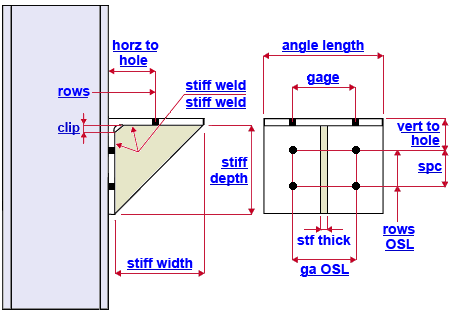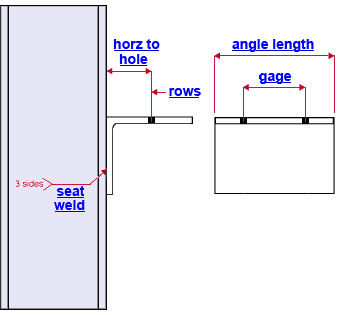"  Seated Angle " connection design locks
Seated Angle " connection design locks
| An angle seat for a joist top chord can be designed per " |
|
|||||
| " (" Top chord seated " = ' Stiffened L ') (" Seat to supporting member " = ' Bolted ')  |
" (" Top chord seated " = ' Unstiffened L ') (" Seat to supporting member " = ' Welded ')  |
||||
|
|||||
Connection Guide: Click here and here for related screen shots.
User Defined Connections: Settings that are locked (
) in the user defined connection file will automatically be locked on the member edit window. You can, if you so choose, manually lock additional settings on the member edit window, and your changes will be retained, through multiple processes, so long as you do not change to a different connection then switch back to the original user defined connection.
Joist Edit: To change a setting, first set it to locked (
). Related settings that are unlocked (
) may be updated, and the "
Left/Right end limit state " calculations will be updated. Settings that are locked (
) will not be changed by connection design , even if doing so might prevent a connection failure.
Connection design locks :
| Locks not dimensioned or called out on the drawing are marked ( not depicted ). |
![]() Seated Angle
Seated Angle
Angle
Length ( angle length ): The length that you want the angle to be cut to. This is the distance from the near side edge of the angle to its far side edge. For an angle seat that welds to a column flange, as is shown in one of the examples above, the angle length needs to be less than the column's flange width in order to allow room for the weld.
Material ( not depicted ): The section size of the angle material to be used for the joist seat. For example, L4x3x5/16. The section size you enter here must exist in the local shape file and must be an angle, or validation will not accept your entry. To enter an angle section size, you can type in the section size that you want, or you can press the "file cabinet" browse button (
) and double-click any section that is on the list of available angles in the local shape file . If this field is unlocked (
), you will find that the material listed here is also in Home > Project Settings > Fabricator > Standard Fabricator Connections > Preferred Angle Sizes .
Field bolts in the seat
Diameter ( not depicted ): The bolt diameter. You can either type in any diameter (inches or mm), or you can select a bolt diameter from the combo box (
). The diameters that are listed in the combo box come from Home > Project Settings > Job > Bolt Settings > the " Available bolts " list. The bolt diameter entered here, together with the " Hole type " selected below, set the diameter of holes for field bolting the angle to the top chord of the supported joist.
Hole type ( not depicted ): Standard round or Short slot or Oversized or Long slot or User slot #1 or User slot #2 . The hole type selected here, together with the bolt " Diameter " entered above, set the diameter of holes on the leg of the angle seat that field bolts to the top chord of the supported joist.

Rows: The number of rows of holes ( 0 or 1 or 2 or 3 ) for field bolting the angle seat to the joist. ' 0 ' rows specify that the seat field welds to the joist. If ' 2 ' or ' 3 ' rows are entered, the " Bolt spacing " that is set for the bolt diameter, in Connection Detailing/Fabricator Options , is applied as the row spacing. ' 1 ' row is shown in the example .
Horizontal to holes ( horz to hole ): The distance from the end of the joist to the center of the first row of holes in the angle seat (see example ). The end of the joist is not shown in the model. To calculate where the end of the joist is positioned, you need to subtract the " Setback " (" Field clearance " or " Input minus dimension " or " Automatic minus dimension ") for that end of the joist.
Gage: The distance (center to center) between the two columns of holes in the angle seat. These holes are used for field bolting the angle seat to the top chord of the supported joist -- see example .
Stiffener plate (" Top chord seated " = ' Stiffened L ')
Depth ( stiff depth ): The length of the stiffener edge that welds to the angle leg that welds (or bolts) to the supporting member (see example ). The distance is measured parallel with that same angle leg. This applies when ' Stiffened L ' is the " Top chord seating " for the joist seat.
Width ( stiff width ): The length of the stiffener edge that welds to the angle leg that bolts to the joist (see example ). The distance is measured parallel with the horizontal angle leg. This applies when ' Stiffened L ' is the " Top chord seated " for the joist seat.
Thickness ( stf thick ): The " Material thickness " of the stiffener plate (see example ). This applies when ' Stiffened L ' is the " Top chord seated " for the joist seat.
Clip: The distance from the corner of the stiffener plate (before it is cut) to where you want the 45 degree cut to begin. This corner clip prevents interference between the stiffener plate and the fillet of the angle (see example ). Enter ' 0 ' if you do not want the corner clipped. This applies when ' Stiffened L ' is the " Top chord seating " for the joist seat.
Bolts in angle OSL leg (" Seat to supporting member " = ' Bolted ')
Diameter ( not depicted ): The bolt diameter. You can either type in any diameter (inches or mm), or you can select a bolt diameter from the combo box (
). The diameters that are listed in the combo box come from Home > Project Settings > Job > Bolt Settings > the " Available bolts " list. The bolt diameter entered here, together with the " Hole type " selected below, set the diameter of holes for shop bolting the vertical leg of the angle seat to the supporting member.
Hole type ( not depicted ): Standard round or Short slot or Oversized or Long slot or User slot #1 or User slot #2 . The hole type selected here, together with the " Bolt diameter " entered above, set the diameter of holes for shop bolting the vertical leg of the angle seat to the supporting member.

Rows ( rows OSL ): The number of rows of holes in the leg of the angle that shop bolts to the supporting member (the column in the example ).
Vertical to holes OSL ( vert to hole ): The distance from the top face of the angle (which supports the joist) to the first row of holes in the leg of the angle seat that shop bolts to the supporting member (the column in the example ).
Gage ( ga OSL ): The distance (center to center) between the columns of holes in the leg of the angle seat that shop bolts to the supporting member (the column in the example ).
Spacing ( spc ): The distance (center to center) between rows of holes in the leg of the angle seat that shop bolts to the supporting member (the column in the example ).
Welds
Seat ( seat weld ): The weld size for shop welding the angle to the supporting member (the column in the example ).
Stiffener ( stiff weld ): The weld size for shop welding the stiffener to the legs of the angle. See the example . This applies when ' Stiffened L ' is the " Top chord seated " for the joist seat.







